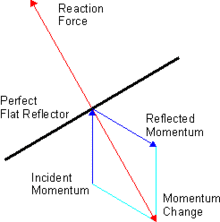
Back ضغط إشعاع Arabic Ціск электрамагнітнага выпраменьвання Byelorussian Pressió de radiació Catalan Strahlungsdruck German Premo de radiado Esperanto Presión de radiación Spanish فشار تابش Persian Säteilypaine Finnish Pression de rayonnement French לחץ קרינה HE

Radiation pressure (also known as light pressure) is mechanical pressure exerted upon a surface due to the exchange of momentum between the object and the electromagnetic field. This includes the momentum of light or electromagnetic radiation of any wavelength that is absorbed, reflected, or otherwise emitted (e.g. black-body radiation) by matter on any scale (from macroscopic objects to dust particles to gas molecules).[1][2][3] The associated force is called the radiation pressure force, or sometimes just the force of light.
The forces generated by radiation pressure are generally too small to be noticed under everyday circumstances; however, they are important in some physical processes and technologies. This particularly includes objects in outer space, where it is usually the main force acting on objects besides gravity, and where the net effect of a tiny force may have a large cumulative effect over long periods of time. For example, had the effects of the Sun's radiation pressure on the spacecraft of the Viking program been ignored, the spacecraft would have missed Mars orbit by about 15,000 km (9,300 mi).[4] Radiation pressure from starlight is crucial in a number of astrophysical processes as well. The significance of radiation pressure increases rapidly at extremely high temperatures and can sometimes dwarf the usual gas pressure, for instance, in stellar interiors and thermonuclear weapons. Furthermore, large lasers operating in space have been suggested as a means of propelling sail craft in beam-powered propulsion.
Radiation pressure forces are the bedrock of laser technology and the branches of science that rely heavily on lasers and other optical technologies. That includes, but is not limited to, biomicroscopy (where light is used to irradiate and observe microbes, cells, and molecules), quantum optics, and optomechanics (where light is used to probe and control objects like atoms, qubits and macroscopic quantum objects). Direct applications of the radiation pressure force in these fields are, for example, laser cooling (the subject of the 1997 Nobel Prize in Physics),[5] quantum control of macroscopic objects and atoms (2012 Nobel Prize in Physics),[6] interferometry (2017 Nobel Prize in Physics)[7] and optical tweezers (2018 Nobel Prize in Physics).[8]
Radiation pressure can equally well be accounted for by considering the momentum of a classical electromagnetic field or in terms of the momenta of photons, particles of light. The interaction of electromagnetic waves or photons with matter may involve an exchange of momentum. Due to the law of conservation of momentum, any change in the total momentum of the waves or photons must involve an equal and opposite change in the momentum of the matter it interacted with (Newton's third law of motion), as is illustrated in the accompanying figure for the case of light being perfectly reflected by a surface. This transfer of momentum is the general explanation for what we term radiation pressure.
- ^ Stellar Atmospheres, D. Mihalas (1978), Second edition, W. H. Freeman & Co.
- ^ Eddington, A. S., & Eddington, A. S. (1988). The internal constitution of the stars. Cambridge University Press.
- ^ Chandrasekhar, S. (2013). Radiative transfer. Courier Corporation.
- ^ Eugene Hecht, "Optics", 4th edition, p. 57.
- ^ Cohen-Tannoudji, Claude N. (1998-07-01). "Nobel Lecture: Manipulating atoms with photons". Reviews of Modern Physics. 70 (3): 707–719. Bibcode:1998RvMP...70..707C. doi:10.1103/RevModPhys.70.707. ISSN 0034-6861.
- ^ Wineland, David J. (2013-07-12). "Nobel Lecture: Superposition, entanglement, and raising Schrödinger's cat". Reviews of Modern Physics. 85 (3): 1103–1114. Bibcode:2013RvMP...85.1103W. doi:10.1103/RevModPhys.85.1103. ISSN 0034-6861.
- ^ Weiss, Rainer (2018-12-18). "Nobel Lecture: LIGO and the discovery of gravitational waves I". Reviews of Modern Physics. 90 (4): 040501. Bibcode:2018RvMP...90d0501W. doi:10.1103/RevModPhys.90.040501.
- ^ Schirber, Michael (2018-10-04). "Nobel Prize—Lasers as Tools". Physics. 11: 100. Bibcode:2018PhyOJ..11..100S. doi:10.1103/physics.11.100. S2CID 125788399.